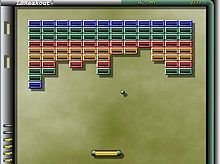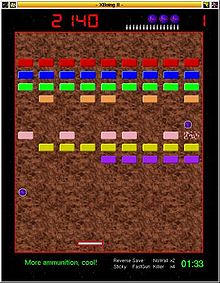Breakout (computer game)
| Breakout | |
|---|---|
| Studio | Atari |
| Publisher | Atari |
| Senior Developer | Steve Wozniak |
| Erstveröffent- lichung |
April 1976 |
| genre | Breakout / skill game |
| Game mode | up to 2 players in turns |
| control | Analog rotary switch; 1 button |
| casing | Standard and Cocktail |
| Arcade system |
CPU - Sound CPU: - Sound chips: - |
| monitor | Raster graphics (horizontal) b / w |
| information | No CPU, 100 ICs |
Breakout (also known as Little Brick Out ) is an arcade game that was first produced as an arcade game by Atari in 1976 . Back then it was still black and white with a multi-colored overlay film and was one of the last games of its kind to be implemented entirely in hardware . This game was later programmed for computers and has also existed as software since then .
It is roughly equivalent to a solo pong , in which one should steer the ball with the racket in such a way that the ball hits “bricks” that are at the top of the screen and makes them disappear. If the racket loses the ball, as in pong, you get a new ball, but you lose the game after losing a certain number of balls. Only when all the "bricks" have been cleared is a level considered won and the next level can begin.
development
Like many early video games, the first breakout game was not yet a real computer game , as it was not a computer with a program running on it , but an electronic circuit that directly implemented the principle of the game. These game electronics were designed by Steve Wozniak , while the game design was by Nolan Bushnell . Nolan Bushnell drew the principle of the game on a blackboard. Steve Jobs , who was then working at Atari, persuaded his friend Steve Wozniak (then at HP) to make this game. Steve Jobs was paid $ 5,000 for the game Breakout from Nolan Bushnell. He only gave $ 350 to his friend Steve Wozniak, who designed the actual game, despite promising him half. Steve Wozniak only needed 45 TTL components to construct the Breakout game. Almost all later versions were then normal computer programs, including the colored clone "Brick Out", which Wozniak developed shortly afterwards together with the computer on which it was to run - the Apple II . Many features of this calculator were initially designed with this breakout clone in mind, as Wozniak suspected that this practical approach would allow him to develop a calculator that contained many practical and few unnecessary, cost-only features. The enormous market success of the Apple II proved this approach right.
successor

In 1986, Gigas and Gigas Mark II from Sega and Arkanoid from Taito, a whole series of games that many associate with the term breakout, came onto the market. Some innovations were introduced. Some “bricks” have to be hit several times before they disappear. Bonus and malus capsules have been introduced which could bring the player advantages (more lives, additional balls, wider clubs, ...) but also disadvantages (shortening the wider club, loss of level, ...).
In the early 1990s, Esprit inventor Meinolf Schneider came out with BOLO . 1997 Arkanoid Returns appeared for Arcade as well as a Pop 'n Bounce for the Neo Geo , many versions also appeared for the Amiga . The game Alleyway was also released for the Game Boy . In this game the bat is a spaceship and the pilot is Super Mario . In the 2000s, a variety of games for the PC such as B. Ricochet Lost Worlds Recharged and Wilkanoid . Both have download options for level sets created by fans.
An alternative Magicball part 1–3 also presented Breakout in 3D for the first time. A popular current breakout clone for Windows is also the freeware game DX-Ball, which is based heavily on the Amiga classic Megaball.
For the PC, Ricochet Infinity , a new type of BreakQuest with physically correct behavior of many geometrically complicated models to be dismantled and a Reaxxion with a fund of graphic effects such as morphing and fluorescent light etc. represent the state of the art.
This game can be found on the 1st to 5th generation iPod under the name "Brick", allegedly as a reminiscence of Steve Wozniak.
With the introduction of the new iPod Nano 2nd generation and iPod Classic generations, there is a completely revised version of “Breakout” called “Vortex”. Here the "bricks" are no longer "shot down" in a horizontal line, but in "tunnels", which are graphically designed differently depending on the level. Here u. a. also the humorous side of the programmers: in the first level you can see “Infinite Loop” on the left and right, which is known to be Apple's company address in Cupertino . The game can be downloaded from the iTunes Store.
Trivia
Some Apple products included Breakout as an Easter egg, for example the MacOS 7.5 operating system.
See also
Individual evidence
- ↑ Steve Wozniak : iWoz. How I invented the personal computer and co-founded Apple. Deutscher Taschenbuchverlag, 2008, ISBN 978-3-423-34507-1 , pp. 144-149.
- ↑ Steve Wozniak, Gina Smith: iWoz. Computer geek to cult icon: how I invented the personal computer, co-founded Apple, and had fun doing it . 1st edition. WW Norton & Co, New York 2006, ISBN 978-0-393-06143-7 (English).
- ↑ MacKiDo / EasterEggs / Breakout. Retrieved June 15, 2018 .
Web links
- Breakout (computer game) in the Killer List of Video Games (English)
- "Breakout" games at MobyGames (English)
- The Atari module breakout
